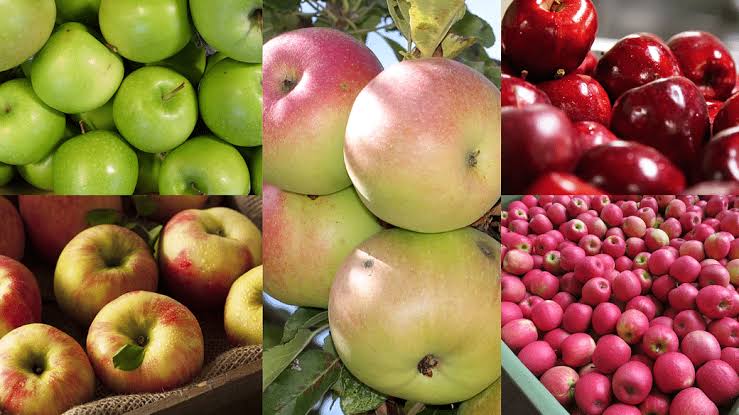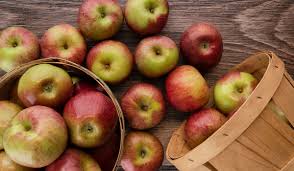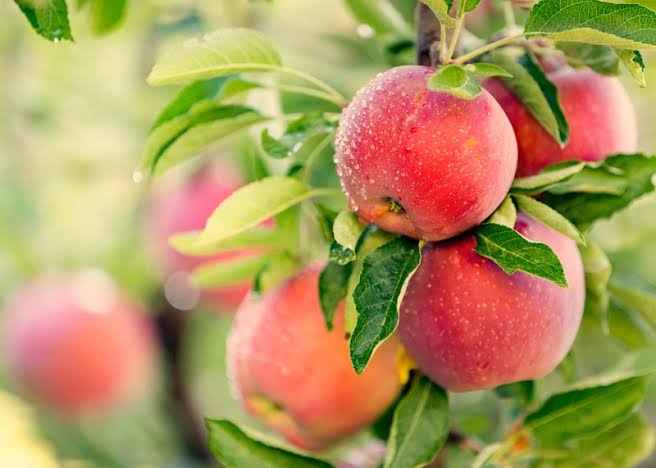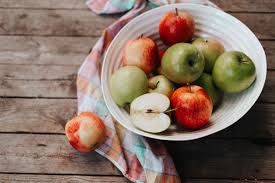Apples are tasty fruits that come in various colors like red, green, and yellow. These fruits grow on apple trees, and people all around the world enjoy eating them. You can find apples in grocery stores, markets, and even pick them from apple orchards.
One fascinating thing about apples is their diversity in flavors. Some apples are sweet, while others are a bit tart. The sweetness and tartness depend on the type of apple. Popular varieties include Gala, Granny Smith, Red Delicious, and Fuji. Each type has its own unique taste, making apples a versatile snack for different preferences.
Not only are apples delicious, but they are also good for your health. They are packed with essential nutrients like vitamins and fiber. Eating apples can help keep you healthy and provide energy. The saying “an apple a day keeps the doctor away” highlights the health benefits associated with regular apple consumption.
Apples are often used in various culinary creations. They can be used in pies, crisps, sauces, and salads. Additionally, apple cider is a popular beverage made from pressed apples. This versatile fruit adds a delightful flavor to both sweet and savory dishes.
In addition to being tasty and versatile, apples have an interesting history. They have been cultivated for thousands of years, with origins traced back to Central Asia. Over time, different apple varieties have been developed through selective breeding. Today, apple orchards can be found in many countries, contributing to the global availability of this beloved fruit.
Apples also play a role in cultural traditions and folklore. They are often associated with autumn and harvest festivals in many cultures. In some places, people engage in apple picking as a fun seasonal activity. Moreover, apples are sometimes linked to stories and myths, adding a touch of enchantment to their reputation.
As you bite into a crisp apple, consider the journey this fruit has taken—from ancient origins to the modern-day grocery store. Its rich history, diverse flavors, and nutritional benefits make apples not only a delicious snack but also a fascinating subject to explore. So, the next time you enjoy this simple yet remarkable fruit, savor the taste and appreciate the story behind the apple on your plate.
Read Also: Types, Importance and Uses of Rice
Types of Apples

There are numerous types of apples, each with its own distinct characteristics. Some of the popular varieties include:
1. Red Delicious: Known for their bright red color, these apples are sweet and often enjoyed fresh.
2. Gala: Gala apples have a mild, sweet flavor and a crisp texture. They are a favorite for snacking.
3. Granny Smith: Recognized by their green color and tart taste, Granny Smith apples are often used in baking and making apple sauces.
4. Fuji: Fuji apples are sweet, juicy, and have a firm texture. They are a cross between two other apple varieties, making them unique.
5. Honeycrisp: These apples are known for their sweet and crisp nature, making them a popular choice for both eating and baking.
6. Golden Delicious: With a yellow-golden skin, these apples have a sweet and mellow flavor. They are versatile and can be used in various recipes.
7. Pink Lady: Known for their pinkish-red skin and sweet-tart taste, Pink Lady apples are often enjoyed fresh or in salads.
8. Cortland: These apples are crisp and have a slightly tart flavor. They are excellent for salads and baking due to their slow browning when cut.
9. Jonagold: A hybrid between Jonathan and Golden Delicious, Jonagold apples offer a balanced sweetness and tartness, making them suitable for various culinary uses.
10. McIntosh: McIntosh apples have a tender texture and a mildly tart flavor. They are commonly used in applesauce and baking.
These are just a few examples of the many apple varieties available. Each type has its own unique taste and texture, making apples a versatile and enjoyable fruit for a wide range of culinary applications.
Importance of Apples

Apples hold significant importance for various reasons:
1. Nutritional Value: Apples are rich in essential nutrients, including dietary fiber, vitamins (such as vitamin C), and minerals. Consuming apples as part of a balanced diet contributes to overall health and well-being.
2. Health Benefits: Apples are associated with numerous health benefits. The fiber in apples supports digestion, and the antioxidants they contain may help reduce the risk of certain chronic diseases.
3. Diversity in Culinary Use: Apples are versatile in the kitchen. They can be enjoyed fresh as a snack, used in salads, made into sauces, baked into pies, crisps, and cakes, or even juiced for refreshing beverages. This culinary diversity makes apples a staple in many cuisines.
4. Cultural and Symbolic Significance: Apples often carry cultural significance and symbolism. They are linked to traditions like apple picking during the fall season and are integral to festivals and celebrations in various cultures.
5. Economic Impact: The cultivation and trade of apples contribute significantly to the economy. Apple orchards provide employment, and the sale of apples generates revenue for farmers, markets, and grocery stores.
6. Environmental Benefits: Apple trees contribute to environmental health. They absorb carbon dioxide and release oxygen during photosynthesis, playing a role in reducing greenhouse gases. Orchards also contribute to biodiversity.
7. Historical and Folkloric Associations: Apples have historical significance, dating back thousands of years. They are often mentioned in folklore, mythology, and religious texts, adding to their cultural importance.
8. Agricultural Practices: Apples are a major crop in many regions, and their cultivation requires specific agricultural practices. The knowledge and techniques involved in growing apples contribute to the sustainability of agriculture.
In addition, the importance of apples extends beyond their delicious taste. They play a vital role in nutrition, health, culture, economics, and environmental sustainability, making them a fruit of both practical and symbolic significance.
Read Also: How to Grow and Care for Potatoes
Uses of Apples
Apples have a wide range of uses, making them a versatile fruit in various aspects of life:
1. Fresh Snacking: One of the simplest and most common uses of apples is as a fresh and healthy snack. Their natural sweetness and crisp texture make them a favorite for quick, on-the-go eating.
2. Cooking and Baking: Apples are a staple ingredient in numerous culinary creations. They can be used in pies, crisps, cakes, muffins, and bread. Apples add sweetness, moisture, and flavor to baked goods.
3. Applesauce: Cooking apples and blending them creates applesauce. It can be enjoyed on its own, used as a side dish, or incorporated into recipes as a substitute for fats in certain dishes.
4. Salads: Sliced apples bring a refreshing and crunchy element to salads. Their sweet-tart flavor complements both green salads and fruit salads.
5. Cider Production: Apples are a key ingredient in the production of apple cider. This beverage can be enjoyed fresh or fermented into hard cider, a popular drink in some regions.
6. Jams and Preserves: Apples can be cooked down with sugar and other fruits to make delicious jams and preserves. These can be spread on toast or used as toppings for desserts.
7. Drying and Dehydrating: Apples can be dried or dehydrated to create apple chips or rings. This process preserves the fruit, and the resulting snacks are convenient for storage and consumption.
8. Vinegar Production: Apples can be fermented to produce apple cider vinegar. This versatile vinegar is used in cooking, baking, and even as a household cleaner.
9. Flavor Enhancer: Apples can be used to enhance the flavor of various dishes, from savory to sweet. They pair well with cheeses, meats, and other fruits, adding complexity to a range of recipes.
10. Traditional and Medicinal Uses: In some cultures, apples have been traditionally used for medicinal purposes. They are believed to have health benefits, such as aiding digestion and promoting heart health.
11. Festive Decorations: Apples are sometimes used for decorative purposes during festive seasons. They can be incorporated into centerpieces, wreaths, or other arrangements.
These diverse uses showcase the adaptability of apples in the culinary world and beyond. From simple snacks to complex recipes, apples contribute to a wide array of delicious and practical applications.
How to Grow and Care for Apples

Growing and caring for apple trees involves several key steps to ensure a healthy and fruitful harvest. Here’s a basic guide:
1. Selection of Apple Variety: Choose apple varieties that are well-suited to your climate and soil conditions. Some varieties thrive in specific regions, so research which ones are best for your area.
2. Planting: Select a planting site with well-draining soil and full sunlight. Apple trees generally prefer slightly acidic to slightly alkaline soil. Plant apple trees during the dormant season, typically in late winter or early spring. Ensure proper spacing between trees to allow for growth.
3. Soil Preparation: Prepare the soil by adding organic matter, such as compost, to enhance fertility and drainage. Conduct a soil test to determine nutrient levels and make amendments as needed.
4. Watering: Provide consistent watering, especially during dry periods. Newly planted trees require more attention, but established trees also benefit from regular watering.
5. Pruning: Prune apple trees to encourage a strong structure, improve air circulation, and promote sunlight penetration. Remove dead or diseased branches and thin crowded areas to prevent disease.
6. Fertilization: Apply a balanced fertilizer in early spring before new growth begins. Adjust the fertilizer based on soil test results and the specific needs of the apple variety.
7. Pest and Disease Management: Monitor for pests such as aphids, mites, and codling moths. Implement integrated pest management strategies, including beneficial insects and organic pesticides. Regularly inspect trees for signs of diseases like apple scab, powdery mildew, and fire blight. Apply fungicides or other treatments as needed.
8. Thinning: Thin fruit clusters in late spring to ensure larger, healthier apples. This helps prevent branches from breaking under the weight of excessive fruit and improves fruit quality.
9. Harvesting: Harvest apples when they are mature and have reached the desired size and color. Different apple varieties have specific indicators of ripeness.
10. Storage: Store harvested apples in a cool, dark place with good air circulation. Some apple varieties store well in a refrigerator or a cool basement.
11. Winter Care: Protect young trees from winter damage by wrapping trunks and applying mulch around the base. Watering before winter freezes can also help prevent dehydration.
By following these steps and adapting them to the specific needs of your apple variety, you can cultivate healthy and productive apple trees. Regular care and attention throughout the seasons contribute to a bountiful harvest and the overall well-being of your apple orchard.
Read Also: How to Build a Raised Bed Garden

